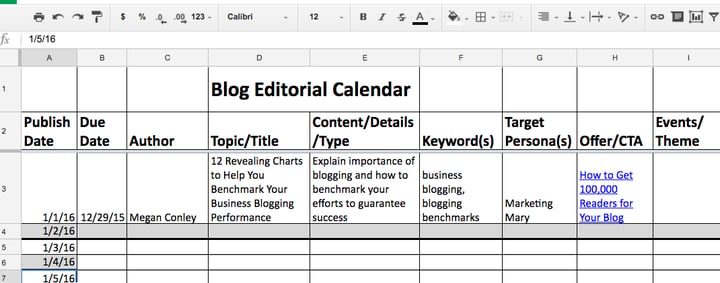So many companies don’t bother with business blogging. Is your business one of them? If you're the marketer in charge, you're probably familiar with the " blog or no blog" dilemma. In this article, we aim to arm you with a business case for getting serious about business blogging and give you some tools to help you get it done.
There are lots of compelling reasons why consistently publishing quality articles on your company blog is not only a good idea but crucial to your company goals. Here are the best reasons:
- Expand online visibility with your ideal customers
- Drive more traffic to your website
- Generate more quality leads
The numbers tell the story:
Companies that published 16+ blog posts a month received almost 3.5X more traffic than companies that published between 0-4 per month. (HubSpot 2017)
Hubspot pulled data from 13,500 customers and discovered a few remarkable truths. Overall, they found that the more blogs published per month, the more traffic they had coming to their website.
Companies that published 16+ blog posts per month got about 4.5X more leads than companies that published 0-4 monthly posts. (HubSpot 2017)
With such compelling evidence, why do so many companies pass on the whole blogging thing?
A few reasons we hear most often are:
- "I’m not sure what we’d get from blogging or how we'd track it, so we’ve made other marketing activities a priority."
- "I’m not sure what we should write about or where to start."
- "Blogging takes a lot of time!"
It’s clear that to grow, a business needs to have a strategy that includes content marketing that will increase website traffic and convert traffic to leads. Putting one in place can be daunting.
11 Business Blogging Tools and 8 Recommended Actions to Crank Out Quality Content
1. Set up a Blogging Editorial Calendar (Google Sheets, Excel)
Get organized by creating a blogging calendar with a spreadsheet. Plan your content strategy for at least 3 months out. The example below can be used to track publish dates, due dates, responsible authors, related keywords, topic/titles, the type of post (list post, how to, etc,) your target persona, the related offer for lead generation, and any theme you may have.
A calendar like this one takes a little effort to set up but it's worth it. Once it's done, executing your blogging plan can flow smoothly.

2. Identify Your Keywords.
Determine the keyword phrases most relevant to your buyer personas. The Google Adwords Keyword Planner is a powerful, but free, tool to research keywords related to topics you want to write about. Each blog post should feature, and be optimized for, one keyword phrase for which you’d like to rank and be found. There are many premium keyword tools as well. There are many premium keyword research tools, too. We use the HubSpot Keyword tool integrated into the HubSpot blogging platform.
3. Start Your First Draft
We suggest you start a first draft for a month of topics at the same time rather than starting and finishing one at a time. We use Google Docs to write and store our blog post drafts. Google Docs makes it easy to co-create, track versions, and share. Start each article document with the following information:
- A “working title” ie “What’s the article about?”
- What do you want the reader to do, feel, or know after reading the article
- The focus keyword and buyer persona
- An outline that includes the introduction and premise of the article, three or more relevant points supporting your premise, and a call to action.
As you find resource material, add snippets and links to the First Draft document. When you're ready to finish the article, you'll have everything you need to write a quality piece of content.
4. Fill Your Editorial Calendar with the Hubspot Blog Topic Generator
Not sure what to write about? Try this Blog topic generator from Hubspot and get a year’s worth of topics for your blog.
5. Analyze and Refine Your Title
Your blog title or headline is what will make your article attractive and shareable. Your headline will either help or hurt your website's SEO. Use the CoSchedule Headline Analyzer to improve your headline. Refining your headline before you finish writing your blog can help you write.
6. Find Inspiration and Resource Material
We use several tools to find similar content to use as resource material.
Buzzsumo.com Search for the most shared content on the internet with your keyword phrase to learn what your target market is reading. Buzzsumo has a free and a paid version.
Feedly.com is a feed reader that will search the internet for articles related to all your keywords and organize them into topic-based folders. Feedly has a free and pro version.
Organize your resource material and web pages in Evernote with the Evernote Web Clipper.
Create notebooks in Evernote of web pages that inspire you and provide resource material. Evernote can be accessed from your computer or any mobile device.
7. Add Visual Content.
Online content is more engaging when it includes images. Make sure you have a social media-ready image for each blog post. Use your images or stock images to give pizzazz to your post. Canva.com is the best online resource for creating visual media. With its social media-ready templates and editing tools you can create stunning images, infographics, and calls-to-action buttons for your post.
8. Add a Call-to-Action to the End of Your Post.
Last, but not least, make sure you generate leads from your awesome posts by adding an eye-catching call-to-action (CTA) to invite your readers to download an offer and capture their contact information. Notice our example at the end of this post on how to create CTA's that rock.
Next Steps
To be productive, schedule time to write and stay focused. The more you write, the easier it becomes and the more you can produce in less time. Here’s a bonus tool to help you stay focused and get it done! The Pomodoro Timer.
We'd be super happy for you to share this article so others may be helped by these tools and recommendations.
Marketing Monsoon, LLC is a growth agency specializing in lead generation, sales enablement, and customer engagement for alternative energy, healthcare technology, and staffing and HR companies. Our expertise includes strategy development, content marketing, lead generation systems, local search marketing, social media marketing, and email marketing. Get started on your strategy today by reaching out to Marketing Monsoon at (866) 851-1793.








